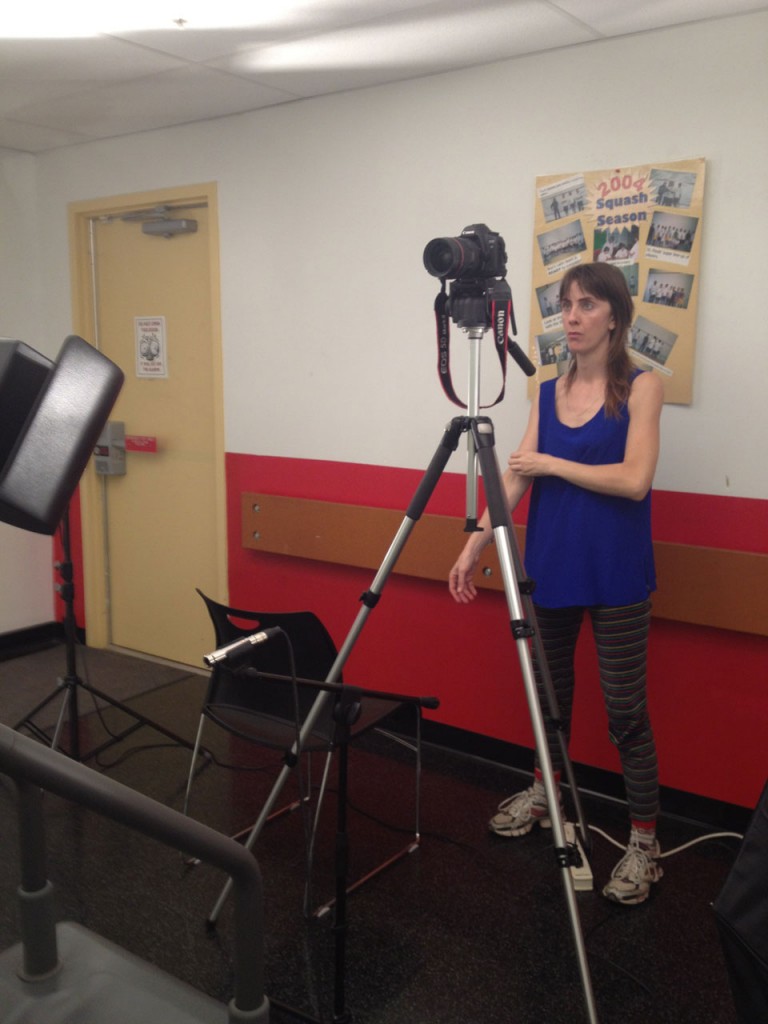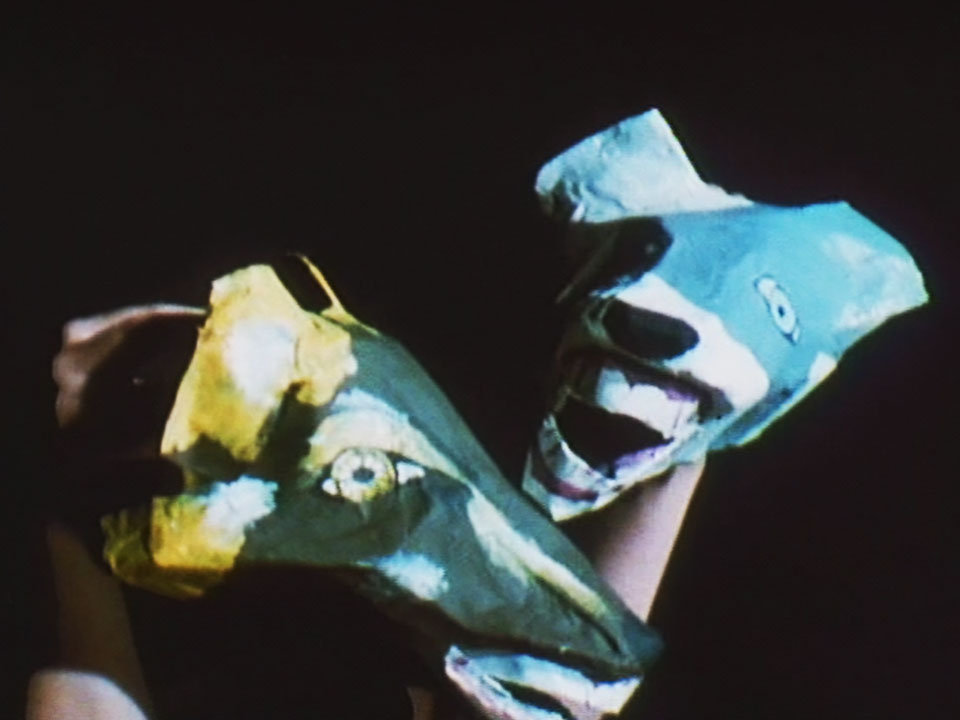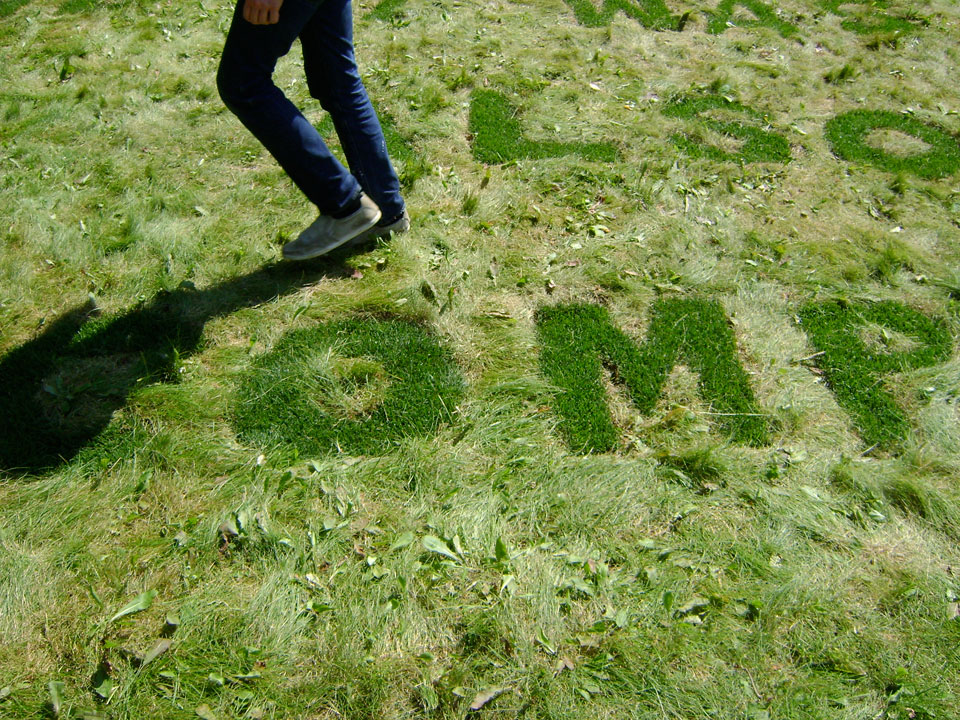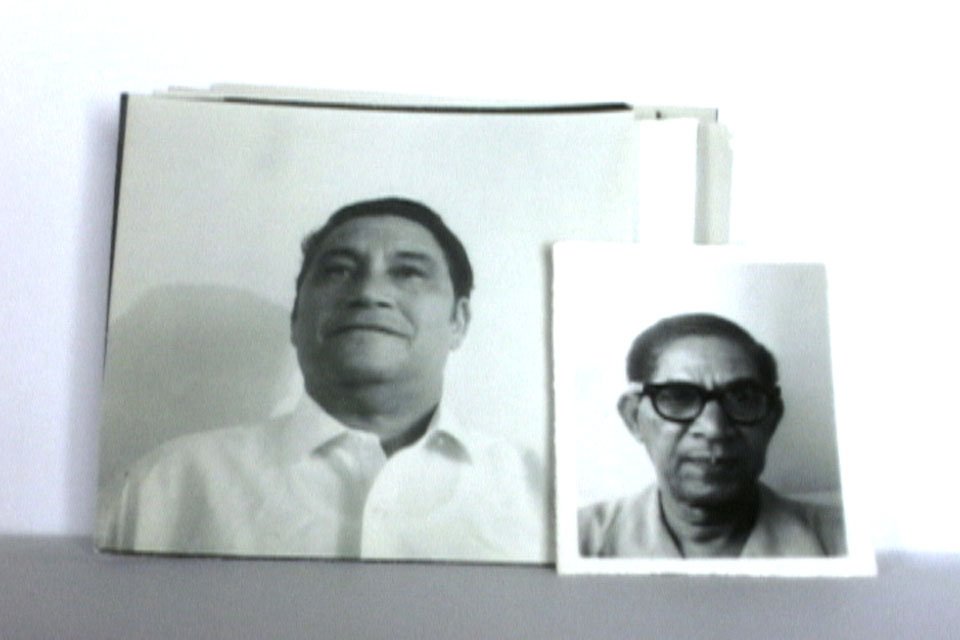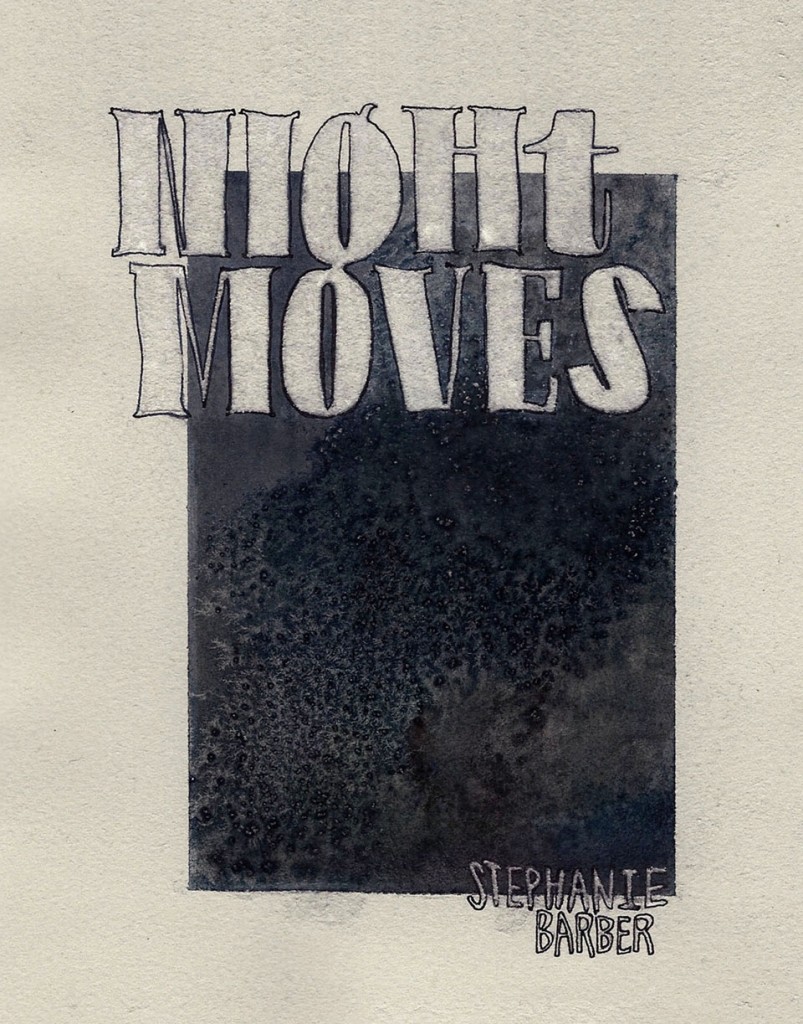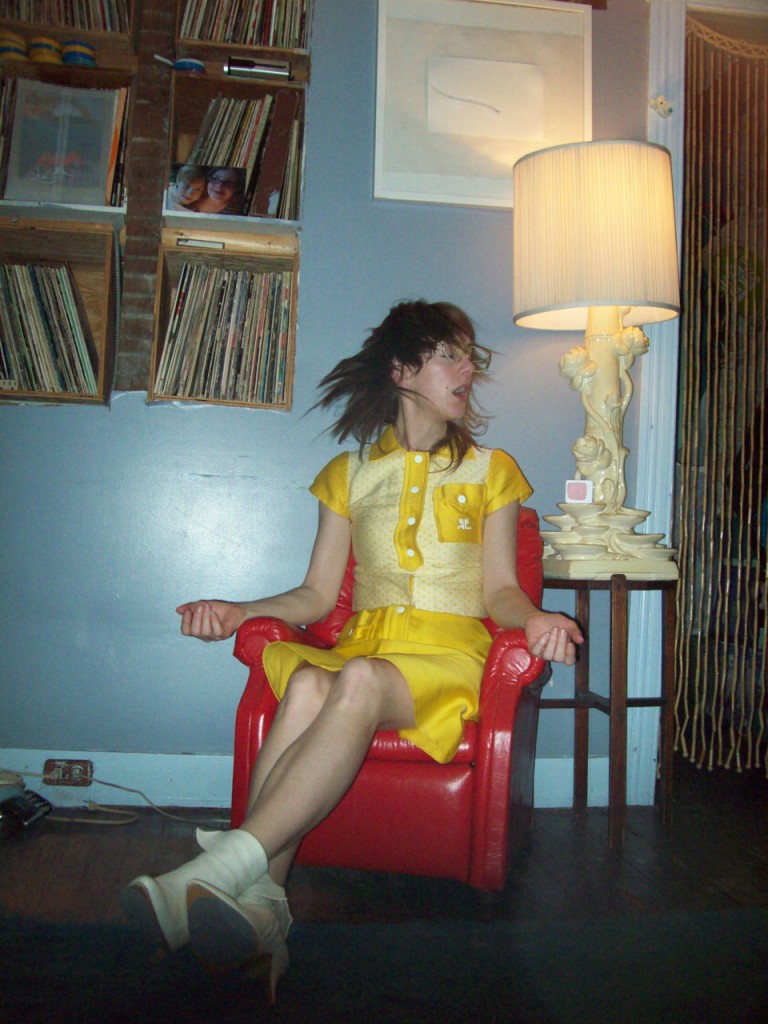Stephanie Barber
There appears to be no topic that might suddenly become a crucial part of a conversation with Stephanie Barber. From the history of jazz and Wittgenstein to wigs and the price of canned garbanzos, Stephanie Barber embraces the esoteric and the mundane as material for her films, videos, sound, performances and writing. One critic described her work as ‘a profound dose of ordinary magic’. I think this comment gets at the surprising force of her work. With the most economical of means, Barber creates entirely idiosyncratic yet accessible worlds. Her films and videos have been screened at such prestigious institutions as the Tate Museum in London, MOCA in Los Angeles and the Whitney and MoMA in New York. In 2002, she moved from Milwaukee to Baltimore and has had a vibrant impact on the community not only as an artist but also as host of many screenings and literary events in her studio space on the east side.
She was a finalist for the Sondheim Prize in 2011 and for all intents and purposes, lived in the galleries of the Baltimore Museum of Art for a month making art, interacting and often collaborating with museum visitors. Her new book Night Moves is a transcript of You Tube comments on the Bob Segar song of the same name and will be released by Publishing Genius Press in early 2013. This interview took place in Baltimore, January 2013
MAD: Do you remember having a formative esthetic experience as a child? The first time you appreciated or perceived something in terms of its beauty or form or structure?
SB: I feel like I had a lot. One is that I wrote poetry from when I was very little and I learned how to use the typewriter so that I could type the poem because I felt like typing the poem was the thing that made it complete. I think that I thought that typing was publishing, that typing was how the world knew it.
Also I would listen to albums over and over again. I was 2, 3 and 4 and I had a little Fisher Price record player at my grandparents house where I was living and I would do this thing where I would just listen to the same song over and over again and cry. It was a really nice experience, I liked to do it, it was kind of my thing. One time my dad came to visit me and he took the record away, he thought my behavior was too dark, that I was messing myself up. He wasn’t being cruel, he thought he was protecting me.
I still have that tendency, it’s hard to explain but its like self-schadenfruede, a pleasure in the esthetics of sorrow.
MAD: Can you tell me what the song was?
SB: Well there were two, the first was (Singing) “We had joy, we had fun, we had seasons in the sun…….” Goodbye my friends its hard to die, when all the birds are singing in the sky….” (Laughter). The problem was also that my father thought it was a crappy song. He didn’t think it was genuinely deep. But it was working for me when I was two or three.
MAD: That story reminds me so much of your film The Visit and the Play because it raises the issue of whether it is appropriate to question someone else’s depth. Can one or should one second-guess someone’s experience, to doubt their sincerity? I don’t mean in politics or public discourse but in personal relationships, do we accept the other as they are or can we prod them to go deeper?
SB: I do think you can prod someone; my dad was right, it wasn’t a great song.
MAD: Yes, but you were four years old! (Laughter)
SB: Yes, but how do you begin to learn unless someone pushes you? I am conflicted about it, because the Buddhist side of me understands just how silly judgment or even esthetic comparison is but on the other hand, my entire life’s work has been about refining exactly what I think is an elegant artistic gesture. And I do think that some work is categorically better than other work. So you have to tell the child, “Come on, let’s step to it, you are wasting your tears on garbage” (Laughter)
As for the film The Visit and the Play, I think the characters are not so much engaged in that discussion as they are in one character’s frustration with the other’s inability to articulate any of her ‘deep’ ideas. I think she really believes her friend, which is why she is angry with her careless communication.
MAD: So you lived with your grandfather Bill Barber, the musician and tuba player who played with Miles Davis. I don’t think of the tuba as a jazz instrument.
SB: I lived with him during that period. Sometimes I lived with my mom, sometimes with my dad and sometimes with my grandparents. My grandfather played with Miles and John Coltrane and yes historically the tuba was a jazz instrument, think of Dixieland, where the tuba plays the bass line.
MAD: I guess I was thinking of modern jazz, Miles’ cool jazz….
SB: Well my grandfather was there at the inception of that whole thing. My grandfather and Miles went to Julliard together, so they knew each other since they were very young. It was a very small group of musicians who created that scene and sound of what would be called ‘cool jazz’, Gil Evans, Stan Getz, Coltrane, and Max Roach. My grandfather was very involved in classical music, transposing Debussy and other unexpected pieces for the tuba.
MAD: Were you aware at the time of how extraordinary your grandfather was? How did it trickle into your consciousness?
SB: I was very aware of music. My grandfather was extremely serious and in love with music, he was teaching out on Long Island but would go into Manhattan for studio sessions or to play with orchestras for musicals like ‘The King and I’. But more than anything is that we would stop and listen to music. We would sit quietly and listen. It was like when you sit quietly and read a book. You don’t read a book and do the dishes, or read a book and carry on a conversation. He was, for me, a model of someone who dedicated his life to his art. So many people just stop making art, associating it with being something you do when you are young or only if you achieve a certain amount of critical or financial support.
MAD: Although you were primarily a writer, eventually you went on to study film in college. Was there something about the culture of experimental film; was it a particular film that you saw that led you in that direction? It is so evident in your work how important language is yet what was it about film, about moving images that compelled you?
SB: Yes, serendipitously I took an experimental film class with Larry Gottheim, the very first film we saw on the very first day was Tony Conrad’s The Flicker, which is an abstract film that goes back and forth between black and white flashes. I am not so into abstraction now but at the time I was very moved by it. While I was watching I started crying in that pleasurable way (This is a theme right? Laughter). And I thought to myself, ‘Oh, they are making poetry with film”, and that very day I became a film major. I also liked all of the technical things one had to learn to make a film. With writing its so easy to fall into your interior reality, your imagination, but with film because of the technical restraints, it gives you a bit of an armature that keeps you tethered to the real world, and that balance is important to me.
MAD: Keeping in mind that generation of abstract or structuralist filmmakers who were so dominant, and in some ways still are, whose works rarely involved language and were aggressively non-narrative. Did you meet some resistance in your attempts to marry moving images to your poetic impulses?
SB: At the very beginning I just kind of toed the line and made those experimental films that people still make that ape a certain esthetic, a visual cadence….
MAD: The tradition of the avant-garde…..
SB: Yes, but I did make a film early on reworking Bertolt Brecht’s testimony to the House Un-American Activities Committee in 1947, so that involved language, but it was more rare to work with your own language and I did not start that until I was out of college. It was then I found a way to combine my humor, my philosophical questions and experimentation with moving images. In some ways I feel connected to that tradition but my work is in between worlds.
MAD: It an interesting predicament for many contemporary filmmakers who do not align themselves exclusively with particular traditions – they might make feature length narratives, and experimental documentaries…. They fear being too eclectic but should one deny one’s broad interests in service of a tradition?
SB: They are too avant-garde for the avant-garde. I wonder if that is a problem for other mediums but I suspect it’s not quite as territorial. I think that market forces actually propel work in many other mediums toward innovation, because innovation or novelty is valued. But with the tradition of experimental or avant-garde film there is no economic pressure pushing it, so it tends to feed off itself, the canon is continually reaffirmed by teaching and programming, making it a little stagnant. That’s part of the reason why so many younger filmmakers show their work in galleries and museums.
MAD: Back to your work with language. You did this great piece called Lawn Poem, can you describe that a bit?
SB: The Lawn Poems are poems set in grass. Using a stencil I cut out two-foot letters and replace what I cut out with a different colored sod. I have proposed many Lawn Poems but I have actually only done one at the Poor Farm in Wisconsin, which is run by Brad Killam and Michelle Grabner. The overall dimensions of the poem are something like 70 by 300 feet. Originally I wrote this experimental essay called ‘For a Lawn Poem’ sort of in lieu of an artist statement I was supposed to deliver at a residency I was doing in Beloit. It’s a lecture and slide show with photographic prototypes and weaves in and out of artistic autobiography, poetics and general questions about language. Like, what does poetry do? How does it work on us? How does it change us does it change in regards to the medium in which we receive it? How does language affect our interface with the world? Pretty basic but important questions. The essay is loosely formatted as an infomercial–a sort of pitch to get someone to buy a lawn poem. It’s published as an online chapbook at Publishing Genius Press.
MAD: I like your ongoing connection between art and language. This is a strategy in conceptual art as well, where it is the relationships between idea, gesture, object, language and documentation that cumulatively create the work. We know the monumental works of Smithson, Oldenburg and Holt for example, but their proposals, their sketches for works never made are just as important. I love the way your Lawn Poems contribute to the legacy of Earth Art and Conceptual Art. I think this work is serious and ambitious but also a bit irreverent. Its not cynicism but your work seems to ride a line between contradictory attitudes, between skepticism toward contemporary art and a deep commitment to it.
SB: I don’t feel at all cynical about contemporary art, it’s sort of the only thing I am not cynical about. For the concept of art I am reverent, I am dead serious about it, I am a militant believer, like a missionary I want to go out into the world to tell the people to make art, I think it’s essential for our societies and our individual souls. I perhaps, have a bit of an aesthetic aversion to packaging my work or ideas in a certain “professional” manner that may read as irreverence.
MAD: Another overall quality of your work is an economy of means; you do so much with so little. For example the characters in The Visit and the Play are apparently little finger puppets bobbing out of field of wigs (Laughter) but they are fully developed characters, not mere silly symbols, but recognizable personalities who represent very different philosophical positions. One of my favorite films of yours is Dwarfs the Sea in which we see a hand dropping a series of small black and white photographic portraits of men who apparently work on some kind of ocean liner or tanker. The off-screen narrator is a computerized female voice that describes the men and their relationships dispassionately but with a great deal of intimacy. When you were writing the script for that were you sifting through those photographs in much the same manner as we see in the film?
SB: Yes, although there are a lot more photographs than what we see in the film, but yes I was laying around writing about who these men might be. I didn’t know exactly what the project would be, but this is something that I do a lot, to write from photographs. I was happy with the way it looked, dropping one photograph upon the other. I like the way photographs stack up, the tenderness of their proximity. With the script, as with most of my work, I am trying to compose a narrative arc. So I had all of these descriptions of the photographs and I had to pare it down to tell a story of these individuals and then try to deepen and broaden what the narrator says in order to make it more formally engaging and dynamic so it becomes a larger treatise on life at sea (the inherent pun (asea) and metaphor for our existence) in general. You know, trying to glide sort of gracefully into the more universal and existential ideas without being didactic. But yes, my work is often engaged in distillation. For the last four years I’ve written one haiku everyday and this is the most obvious formal distillation I’ve been focused on but so many of my films and videos are working with the same impulse. Saying something complex in a simple or seemingly off hand manner, or saying something large with the slightest gesture. Or saying something devastating with humor. I think these are different but related distillations. I mean, all art is distillation (and translation I guess) if we think about the large unruly space our imagination is.
MAD: It so connects to some philosophical writing on photography, Roland Barthes’ Camera Lucida especially, in terms of specificity and universality. What I also admire about your work is that you are unafraid of going to ‘cheesy depths’ to use your term. Young artists are sometimes faulted for being too earnest or sentimental, they are encouraged to develop critical and formal distance. I understand why but the danger is that heartfelt content is drummed out of an artist. The result is that artists censor themselves, don’t want to be seen as corny or, god-forbid, sincere and un-ironic. This robs us of real feeling. You are unafraid to go there, its not like you wear your heart on your sleeve. But you find ways, such as the computerized female narrator’s voice, I mean she might be human or she might be god, in order to venture into profound questions about individual and collective loneliness.
SB: That is important to me. I think that balance is achieved in Dwarfs the Sea, although other works such as ‘Dogs’ are a little less restrained and I am not sure everyone goes with me, some think it’s too sentimental or direct. Dogs is an example of a piece working backwards from distillation. I am really asking myself to explore the ideas the dogs are sharing with each other but I am also trying to balance the way it formally moves as a film. That is, the way that it begins as an awkward discourse and moves to a deepening, relaxed naturalism (which trope ‘Spike’ comments on when he says that perhaps a ‘wrong choice can make the whole piece better’) and then moves oddly away from the dialog and into the poem then abruptly stumbles towards an awkward goodbye. So that the impulse to allow myself to ‘go deep’ is tempered, not by obfuscation (a common tack) but by a formal specificity which (ideally) keeps the sap in check.

Stephanie Barber, ‘Jhana and the Rats of James Olds’, installation view, Baltimore Museum of Art, 2011
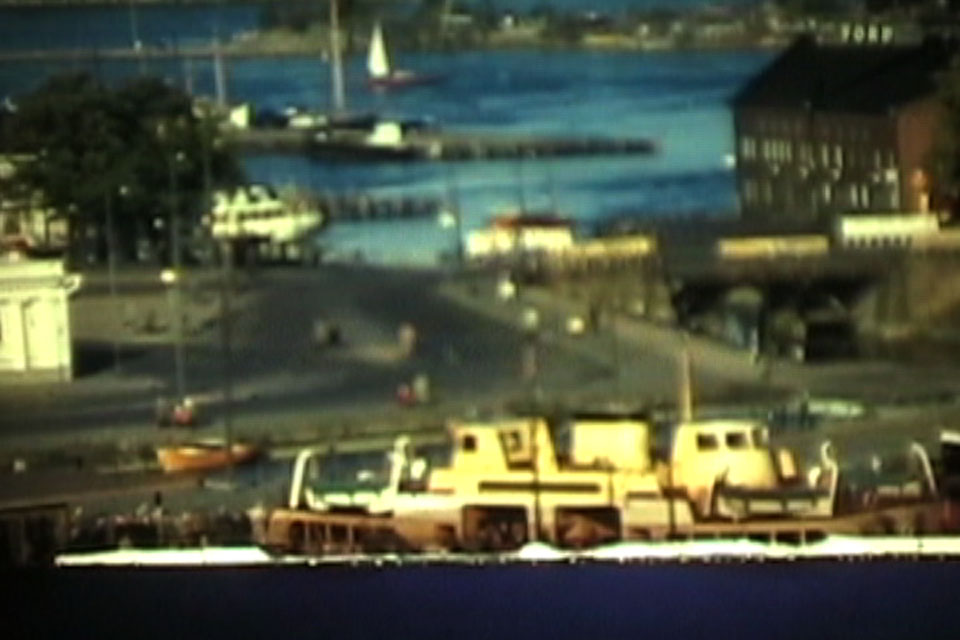
Stephanie Barber, still from ‘For W.G. Sebald (Travel without Travel)’ from ‘Jhana and the Rats of James Olds’ 2011
MAD: You were a finalist for the Sondheim Prize in 2011 and each of the finalists presented their work at the Baltimore Museum of Art. You chose to basically live in the gallery. You set up your studio to make art while you were interacting with the public. You often incorporated the viewers into your work. What was that like?
SB: I moved my whole studio into the museum, everything that I use to make work, cameras, computers, a keyboard and other musical instruments, recording equipment and collage materials. The goal was to make a new video each day, complete to export, which was then shown on a monitor with the other finished pieces the next day. In another room two earlier videos of mine were projected (Dwarfs the Sea and Bust Chance). The videos vary wildly in content and composition. There are silent pieces and heavily acted pieces and music videos and the whole experience was just so oddly focused and strict but, perhaps because of this I created some very broad and new pieces of work. You know, outside of my usual moves. (Though, there are a good number of pieces of my video camera just looking at photographs!). The project was called Jhana and the Rats of James Olds and, well, Jhana is an altered state achieved through meditation–a mystical enlightenment–and James Olds is the psychologist who is well known for having discovered the ‘pleasure center’ of our brains–the nucleus accumbens in the 1950s. Interestingly, recently scientists have proposed that the ‘pleasure’ derived from the nucleus accumbens is achieved through engaging work–it is not, like, a narcotic pleasure, or however we think of pleasure–sensual, or something. The modern take on this is that real pleasure is attained through focused work. And, of course, practiced meditators have known this all along, and so many books from the last decade, like Flow, and other popular titles are hawking this notion. This project at the BMA was incredibly pleasurable and wickedly difficult. I felt, for 6 weeks, like an internal athlete and also a bit like a crazy hoarding capitalist! Like every nice idea that passed through my mind on, like my bike ride to or from the museum, needed to be utilized and productivized! Knowing the rigors and rewards of what I was committing myself to do brought me to naming the piece in a sort of anticipation of the mental processes needed to go forward.
Anyway, yes, PEOPLE! They were great and stressful in turns. There were so many wonderful interactions with people who ended up being in the work usually by doing voice-overs or singing. In the morning I would write a script of sorts and if the piece involved a voice I would, as people came into the gallery ask them to read. That in itself was an amazing experience to hear back in other people’s voices, words that I had just written. Another thing I did throughout the entire length of the exhibition was to record people saying, “I love you” to one of my video cameras, so I have over 800 people saying “I love you”, and I knew I wanted to use those for the last video. It’s just so beautiful. Just asking people to say those three words was a big part of the dialog, there was often some kind of negotiation, people would say, “It feels weird saying ‘I love you’ to you”. And I would respond “Don’t think of it as me. Look at the camera and say it to an imagined audience or say it to someone you are thinking about, or say it to yourself” So consequently I got into these conversations about love with total strangers. Two different people said to me ‘But I don’t love anyone right now”. A very old man started by saying it very matter of factly, and I don’t know where he went in his emotional memory because it turned in a split second and he started saying it over and over as if he were trying to convince someone it was true.
There is a lot to say about this project. I could go on and on.
MAD: You are publishing a new book called Night Moves. What is that about?
SB: Yes. Well you know the song by Bob Seger, ‘Night Moves’?
MAD: Oh my god, I was not a fan but my younger brothers were, so that album was always blasting from their bedroom.
SB: The book is a compilation, a straight up transcription of all of the YouTube comments responding to that song. And if you can let yourself get into the material and not just dismiss the concept as a conceptual gimmick or one-liner, the material is just so fantastic. Some of them are confessional, remembering their first sexual experience, some are about the ‘art’ of Bob Seger, going back and forth analyzing why it is a great song or why it sucks, basically having a public conversation about art, some are meditations on getting older, then there are ugly and crass statements and the way it switches between these types of statements is so modern, so collaged. It’s an exquisite corpse text, all of these strangers decided to make it together in a very public forum. Its like a YouTube call for a public conversation about mortality, sex and art.
MAD: One last question: You live in this amazing storefront studio in East Baltimore; I was wondering how you found it.
SB: So, yes, when I moved here to Baltimore from Milwaukee I bought and moved into a fully stocked bodega. The first 6 months to almost a year the downstairs was aisles of shelves full of stove top stuffing, canned green beans, bleach, hair relaxer, small plastic bottles of spices, kidney beans…you know, everything you find in a corner grocery in an economically challenged Baltimore neighborhood. The area where the cashier would stand was completely walled off with three quarter inch plexiglass, with a plexi turn-around to stick your money through. Behind the plexi was the register and all the cigarettes and blunts and other valuable or pocketable sundries. I still have boxes in the basement full of dice and small glass tubes with miniature roses and hair ties that say ‘i love Jesus’ and Rit fabric dye and shoe laces….there’s so much stuff in the world! So a lot of the food was eaten or given away to local charities or neighbors. It was a hectic and hysterical and tedious year with mice and dirt and magical discoveries and so much work!
